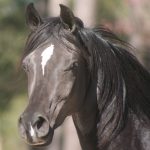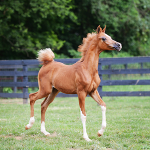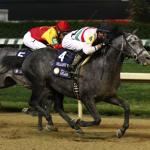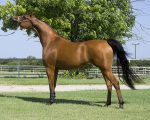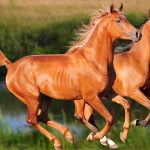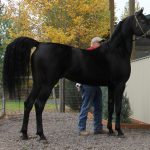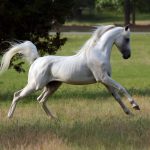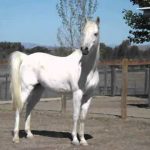Arabian Horse
The Arabian Horse is one of the most popular and expensive horses in the world and is probably known by even those who never dealt with equines. Known for their majestic looks, large stature, and strength, the journey of the modern-day Arabian Horse was millenniums long, beginning from as early as 2500 BC to the present-day Scottsdale Arabian Horse Show. To date, there have been several myths and legends related to this very ancient breed. Interestingly, almost all modern strains are somehow genetically related to the Arabian Horse.
Arabian Horse Pictures
- Arabian Horse Face
- Arabian Horse Farms
- Arabian Horse Foal
- Arabian Horse Head
- Arabian Horse Image
- Arabian Horse Jumping
- Arabian Horse Photos
- Arabian Horse Pictures
- Arabian Horse Racing
- Arabian Horse Show Jumping
- Arabian Horse Show
- Arabian Horse Training
- Arabian Horse
- Arabian Horses
- Bay Arabian Horse
- Black Arabian Horse
- Grey Arabian Horse
- Images of Arabian Horses
- Scottsdale Arabian Horse Show
- White Arabian Horse
Quick Information
| Other Names | Arab, Arabian |
| Behavioral Characteristics & Temperament | Noble, lively, intelligent, bold, affectionate |
| Physical Traits | The profile is slightly concave, massive, compact and well-proportioned with a refined, wedge-shaped head ending in a short muzzle bearing large nostrils, a pair of expressive eyes and curved ears; the arched neck has a clean and refined throatlatch; the back part is short, while the tail is set high |
| Coat Colors | Bay, black, chestnut, and gray are traditional colors; occasionally white, sabino, or rabicano patterns |
| Height/Size | 14.1 – 15.1 hands (adult mares and studs/stallions) |
| Weight | 800 – 1,000 pounds |
| Common Uses | Enhancement of other bloodlines, Racing, Show, Pleasure riding, Work |
| Health Problems | At least, six known genetic disorders have been reported, viz. Severe Combined Immunodeficiency (SCID), Lavender Foal Syndrome (LFS), Cerebellar abiotrophy (CA or CCA), Occipital Atlanto-Axial Malformation (OAAM), Equine Juvenile Epilepsy (or Juvenile Idiopathic Epilepsy), and Guttural Pouch Tympany (GPT), with the first two being conditionally fatal |
| Type | Riding horse, Sport horse, Show horse, Work horse |
| Blood Type | Warm |
| Ancestors (Bloodlines) | Unknown |
| Popular Traits | Quick, multi-talented, efficient, excellent movements, good in jumping, easily trainable, sturdy |
| Feeding/Diet | General horse diet including hay, grass, grains, etc. |
| Country of Origin | Unknown; Developed in the Middle East (especially, in the Arabian peninsula) |
| Associations and Registries | World Arabian Horse Organization Arabian Horse Association (USA) The Arab Horse Society (UK) Emirates Arabian Horse Society Arabian Horse World Arabian Jockey Club New Zealand Arab Horse Breeders’ Society Arabian Horse DataSource Arabian Horse Society of Australia Canadian Arabian Horse Registry Arab Horse Society Arab Horse Society of South Africa National Arabian Horse Society of Russia (NOAL) The Pyramid Society Finnish Arabian Horse Society |
Video: Arabian Horses in the Horse Stud
History and Development
The Arabian Horse is so ancient that the actual origin of these animals is still not known. There are multiple theories regarding its creation, one of which assumes that these horses originated in the regions of modern-day Iraq, Syria and Southern Turkey. Yet another theory says that these horses developed in Southwestern Arabia, around 2500 years before Christ, where they were extensively used as war mounts. The Arabian Horse even became an essential part of the Egyptian empire, where they were used to pull chariots of the monarchs and the aristocrats.
The immense contribution of the Arabian Horse in the foundation and general development of all equine breeds in the world is undeniable. Since centuries, the high-spirited, physically charming, and adaptable Arabian Horses have highly been sought after while making new equine races.
The history of the first domestication of the Arabians, or the type of work they were employed into, is also in darkness. However, by 1500 BC, several historical evidence well suggest that these animals were mastered by the tribal people of the region and were successfully domesticated by them.
It is believed that Mohammad, the founder of Islam, played a crucial role in introducing these horses to the rest of the world, as also, advised his followers to protect these animals, especially the mares that would bear the generations next. According to his instructions, the adherents began to believe that the Arabian Horses were created by God, and those who would take time caring them would be rewarded in the heaven after death.
During the Islamic conflicts in the 7th century AD, the popularity of these large, sturdy equines continued to spread outside of the Arabian realms. While the life of the then Arabian people was mostly nomadic, the Muslim warriors who all had to wander around from place to place with their pet Arabian horses. While traveling through the arid regions of the deserts, they were forced to share their own food with their horses to help them survive the harsh weather conditions, thus creating a special bond between human and animal.
Furthermore, in the recent centuries, the relatively new Bedouin tribe strictly adhered to maintaining the genetic purity of their animals, which in turn, helped the modern day Arabian Horses to survive with all their virtues and physical characteristics.
Around the 12th and the early 13th centuries, the Arabian Horses continued to spread throughout parts of Europe through the Christian Crusaders that were returning home to Europe after their invasions in the East and the Mideast. Soon after, they were made to breed with the existing breeds throughout Europe.
One more factor that served as a strong reason for their further popularity was the invention of firearms, since using these arms by the cavalry required heavy horses, and the Arabian breed served the purpose well, replacing the previously-existing smaller horses in the armed forces.
Finally, during the late 17th and early 18th centuries, there was a prominent change in the scenario of European horses after the revolution of equine breeding largely swept the continent. It was during this period that the Arabian Horses played the pivotal role in the foundation of the English Thoroughbred horses.
With the arrival of the 19th century, the entire continent was studded with horse farms, which gradually became popular in countries like the United States, Russia, Scandinavia, and so on. At present, the Arabian Horse is one of the most successful and sought-after breeds in the Americas, and it gave birth to several types and strains of large and graceful horse breeds in several countries in both the continents. Arabian Horses are extensively used in movies, circuses, parades, and several other places where horses are required.
Interesting Facts
- Emperor Napoleon used to ride on a gray Arabian stallion named Marengo.
- Based on the book written by Walter Farley, a fictional horse in the movie named The Black Stallion was played by an Arabian stallion named Cass Ole back in 1979, and its sequel The Black Stallion Returns in 1983.
- A Muslim legend says that Muhammad, the founder of Islam, chose five of the finest mares (called Al Khamsa, or ‘the five’) that later served as the foundation of the breed.
- An Egyptian legend narrates a story, where the Queen of Sheba gifted King Solomon with an Arabian mare, from which came the first line of these horses.
- Many local people of Arabia still believe that their God ‘Allah’ created the first Arabian horse from the south wind, saying, “Oh Arabian, I create thee. I give thee the power to fly without wings.”
- During the American Revolution, the first president of the USA, George Washington, used a half-Arabian horse named Blueskin.
- Beginning in 1955 with only 50 horses and around 12 owners and trainers, the Scottsdale Arabian Horse Show is the world’s largest show of the Arabian Horses. At present, over 2200 horses and more than 1300 owners participate in the show every year.


